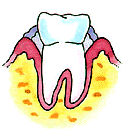| Gum Surgery Post-operative Instructions |

Gum Surgery Post-operative Instructions
If your dentist has diagnosed advanced gum disease that can not be treated with conservative treatments, you may need gum surgery.
For a succesful outcome of a periodontal gum surgery procedure, the patient must follow carefully the post-operative surgery instructions given by the dentist.
How to prepare for a gum surgery procedure?
Before the periodontist decides the most appropriate treatment, will review your medical and dental history, take x-rays to evaluate the damage of jaw bone and perform a thorough examination to determine the overall health of your mouth. Then the periodontist will decide and propose which gum surgery procedures are necessary for your case.
If not already done, the periodontist will perform tooth scaling and root planing to remove as much dental plaque and tartar as possible. Antimicrobial medications are usually prescribed some days before the gum surgery to minimize the risk of post-surgical infection. You will also be advised to follow intensive oral hygiene routine. It is very important for the success of gum surgery, that bacteria have been reduced to the minimum possible before the surgical procedure.
The gum surgery procedure
Gum surgery procedures are performed under local anesthesia so that little or no pain or discomfort is felt during the surgery. The procedure sequence details differ depending on the type of gum surgery. Procedure time, discomfort level and healing time depend also on the severity of the problem and the extend of treatment. A treatment that involves several teeth is expected to be more complex than one involving a single tooth.
Most gum surgery procedures are performed using traditional instruments such as scalpels or dental burs. Lately new techniques such as electrosurgery and laser gum surgery are becoming more popular.
Post-Operative Instructions Following Gum Surgery
Following gum surgery, a periodontal dressing is placed over the gums to protect the surgical site during the healing period. The periodontist may prescribe pain medication to relieve discomfort and an antimicrobial mouthwash to help in preventing infections. Gums will usually start to look normal within a month, while complete healing is expected after two to three months.
General instructions after any gum surgery procedure are the following:
- BLEEDING – some bleeding is normal. You may apply light pressure with a soft cloth to reduce bleeding. Avoid rinsing, spitting or sucking through a straw the day of surgery because it may cause additional bleeding. Call or visit your dentist if there is excessive or continuous bleeding.
- SWELLING – You can have some swelling after gum surgery. This can be relieved with the periodic application of an ice pack placed outside the mouth over the surgical area.
- EATING – Eat soft foods to avoid disturbing the periodontal dressing or injuring the surgical site. Avoid spicy and crunchy foods, or foods that are either too hot or too cold.
- CLEANING – Avoid brushing or flossing the treated area until the periodontal dressing is removed. After that, resume brushing using a soft brush. The rest of the mouth should be cleaned normally, to avoid the growth of dental plaque that could increase the risk of infection.
- SMOKING – Avoid smoking or any use of tobacco, because it could delay healing
- FOLLOW-UP – You should return to the dental office 10-14 days after the gum surgery. During this visit the periodontist will remove the periodontal dressing and evaluate the healing progress. Another follow-up visit is sometimes recommended after one month for patients who have undergone extensive gum surgery.
- COMPLICATIONS – Visit your dentist if the periodontal dressing is displaced or you have excessive bleeding, swelling, intense pain or fever.
- Dental Plaque
- Dental Calculus
- Gum Disease
- Tooth Decay
- Tooth Abscess
- Toothache
- Tooth Loss
Related Problems
- Gum Disease Treatments
- Gingivitis
Treatment - Periodontitis Treatment
- Dental Scaling & Root Planing
- Antibiotics for
Gum Disease - Gum Surgery
- Gingivectomy
- Gum Flap Surgery -
Pocket Reduction - Periodontal
Bone Grafts - Gum Grafts -
Soft Tissue Graft - Crown
Lengthening - Dental Implants
articles about
Gum Disease Treatment
